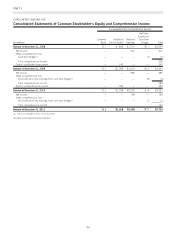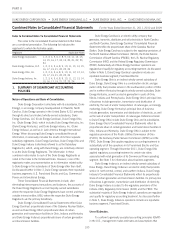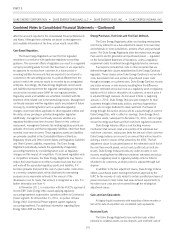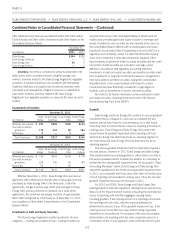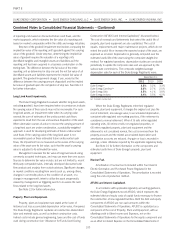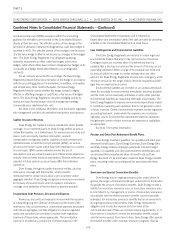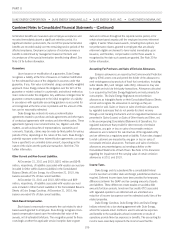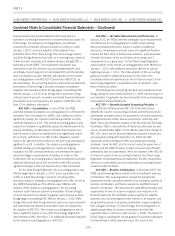Duke Energy 2011 Annual Report Download - page 121
Download and view the complete annual report
Please find page 121 of the 2011 Duke Energy annual report below. You can navigate through the pages in the report by either clicking on the pages listed below, or by using the keyword search tool below to find specific information within the annual report.
PART II
DUKE ENERGY CORPORATION •DUKE ENERGY CAROLINAS, LLC •DUKE ENERGY OHIO, INC. •DUKE ENERGY INDIANA, INC.
Combined Notes to Consolidated Financial Statements – (Continued)
affect the amounts reported in the Consolidated Financial Statements
and Notes. Although these estimates are based on management’s
best available information at the time, actual results could differ.
Cost-Based Regulation.
The Duke Energy Registrants account for their regulated
operations in accordance with applicable regulatory accounting
guidance. The economic effects of regulation can result in a regulated
company recording assets for costs that have been or are expected to
be approved for recovery from customers in a future period or
recording liabilities for amounts that are expected to be returned to
customers in the rate-setting process in a period different from the
period in which the amounts would be recorded by an unregulated
enterprise. Accordingly, the Duke Energy Registrants record assets
and liabilities that result from the regulated ratemaking process that
would not be recorded under GAAP for non-regulated entities.
Regulatory assets and liabilities are amortized consistent with the
treatment of the related cost in the ratemaking process. Management
continually assesses whether regulatory assets are probable of future
recovery by considering factors such as applicable regulatory
changes, recent rate orders applicable to other regulated entities and
the status of any pending or potential deregulation legislation.
Additionally, management continually assesses whether any
regulatory liabilities have been incurred. Based on this continual
assessment, management believes the existing regulatory assets are
probable of recovery and that no regulatory liabilities, other than those
recorded, have been incurred. These regulatory assets and liabilities
are primarily classified in the Consolidated Balance Sheets as
Regulatory Assets and Other Current Assets and Regulatory Liabilities
and Other Current Liabilities, respectively. The Duke Energy
Registrants periodically evaluate the applicability of regulatory
accounting treatment by considering factors such as regulatory
changes and the impact of competition. If cost-based regulation ends
or competition increases, the Duke Energy Registrants may have to
reduce their asset balances to reflect a market basis less than cost
and write-off the associated regulatory assets and liabilities. If it
becomes probable that part of the cost of a plant under construction
or a recently completed plant will be disallowed for ratemaking
purposes and a reasonable estimate of the amount of the
disallowance can be made, that amount is recognized as a loss. For
further information see Note 4.
In November 2011, in conjunction with the PUCO’s approval of
its new ESP, Duke Energy Ohio ceased applying regulatory
accounting treatment to generation operations within its Commercial
Power segment. As of December 31, 2011, no portion of Duke
Energy Ohio’s Commercial Power segment applies regulatory
accounting treatment. For additional information regarding Duke
Energy Ohio’s ESP see Note 4.
Energy Purchases, Fuel Costs and Fuel Cost Deferrals.
The Duke Energy Registrants utilize cost tracking mechanisms
(commonly referred to as a fuel adjustment clause) to recover retail,
and wholesale in some jurisdictions, portions of fuel and purchased
power. The Duke Energy Registrants defer the related costs through
Fuel used in electric generation and purchased power — regulated
on the Consolidated Statement of Operations, unless a regulatory
requirement exists for deferral through Regulated electric revenues.
Fuel expense includes fuel costs or other recoveries that are
deferred through fuel clauses established by Duke Energy Carolinas’
regulators. These clauses allow Duke Energy Carolinas to recover fuel
costs, fuel-related costs and portions of purchased power costs
through surcharges on customer rates. Duke Energy Carolinas records
any under-recovery or over-recovery resulting from the differences
between estimated and actual costs as a regulatory asset or regulatory
liability until it is billed or refunded to its customers, at which point it
is adjusted through revenues. As discussed in Note 4, beginning
January 1, 2012, Duke Energy Ohio procures energy for its retail
customers through a third-party auction, and thus its generation
assets are no longer dedicated to retail customers. Purchases of
energy through the auction process will be a pass-through of costs for
Duke Energy Ohio, with no affect on earnings. Duke Energy Ohio’s
generation assets, subsequent to December 31, 2011, will no longer
recover its energy purchases and fuel costs from regulated customers.
Duke Energy Indiana utilizes a cost tracking recovery
mechanism that recovers retail and a portion of its wholesale fuel
costs from customers. Indiana law limits the amount of fuel costs that
Duke Energy Indiana can recover to an amount that will not result in
earning a return in excess of that allowed by the IURC. The fuel
adjustment clause is calculated based on the estimated cost of fuel in
the next three-month period, and is trued up after actual costs are
known. Duke Energy Indiana records any under-recovery or over-
recovery resulting from the differences between estimated and actual
costs as a regulatory asset or regulatory liability until it is billed or
refunded to its customers, at which point it is adjusted through fuel
expense.
In addition to the fuel adjustment clause, Duke Energy Indiana
utilizes a purchased power tracking mechanism approved by the
IURC for the recovery of costs related to certain specified purchases of
power necessary to meet native load peak demand requirements to
the extent such costs are not recovered through the existing fuel
adjustment clause.
Cash and Cash Equivalents.
All highly liquid investments with maturities of three months or
less at the date of acquisition are considered cash equivalents.
Restricted Cash.
The Duke Energy Registrants have restricted cash related
primarily to collateral assets, escrow deposits, and restricted cash of
101










